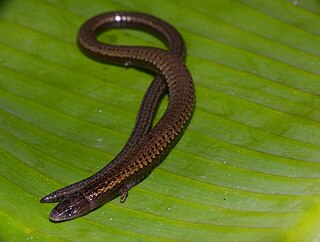
Bachia is a genus of lizards that belong to the spectacled lizards family.

Griswold's ameiva is a species of lizard in the family Teiidae. The species is endemic to Antigua and Barbuda, where it is found on both islands. It is also known commonly as the Antiguan ameiva and the Antiguan ground lizard.

The Guadeloupe ameiva was a species of Teiidae lizards that was endemic to Guadeloupe. It is known from specimens collected by early European explorers. The fossil record shows that it once ranged across Guadeloupe, La Désirade, Marie-Galante, and Îles des Saintes, but in most recent times it was restricted to Grand Ilet, just offshore of Petit-Bourg. It was last recorded in 1914. Its extinction likely occurred when this area was decimated by a hurricane in 1928. The Guadeloupe ameiva was reported as a ground-dwelling lizard. It fed on plants and carrion.
Pholidoscelis maynardi, commonly known as the Great Inagua ameiva, Inagua ameiva, or Inagua blue-tailed lizard, is species of lizard, a member of the family Teiidae. The species is endemic to the Bahamas. Three subspecies have been described.
Censky's ameiva, also known as the Little Scrub Island ground lizard, is a species of lizard in the family Teiidae. It is indigenous to the Caribbean.

Pholidoscelis plei, known commonly as the Anguilla Bank ameiva or the Caribbean ameiva, is a species of lizard in the family Teiidae. The species is found on the Caribbean islands of Anguilla, Saint Martin, and Saint Barthélemy in the Lesser Antilles. Its coloration and markings vary between each island population. Two subspecies are recognized as being valid, including the nominotypical subspecies.
Maringma-tepui, also written Mount Maringma and historically known as Mount Marima, is a small tepui of the Pacaraima Mountains in Cuyuni-Mazaruni, Guyana. It is known as Malaima-tepui in the local Akawaio language. Most published sources place it just inside Guyanese territory, very close to the border with Brazil, and around 17 kilometres (11 mi) east of Roraima-tepui. However, the mountain remains the subject of considerable toponymic confusion and its name has been applied to at least one other nearby peak.
Gelanesaurus flavogularis is a species of lizard in the family Gymnophthalmidae. The species is endemic to Ecuador.
Alexandresaurus is a genus of lizard in the family Gymnophthalmidae. The genus is monotypic, i.e., it contains only one species, Alexandresaurus camacan. The species is endemic to Brazil.
Pantepuisaurus is a genus of lizard in the family Gymnophthalmidae. The genus is monotypic, containing only one species, Pantepuisaurus rodriguesi. The species is endemic to Guyana.
Lepidoblepharis hoogmoedi, also known commonly as Hoogmoed's scaly-eyed gecko and the spotted dwarf gecko, is a species of gecko, a lizard in the family Sphaerodactylidae. The species is native to northern South America.

Auber's ameiva, also known commonly as the Cuban ameiva, is a species of lizard in the family Teiidae. The species is native to the Bahamas and Cuba. There are 40 recognized subspecies.
Andinosaura petrorum is a species of lizard in the family Gymnophthalmidae. The species is endemic to Ecuador.
Arthrosaura tyleri is a species of lizard in the family Gymnophthalmidae. The species is endemic to Venezuela.
Arthrosaura versteegii is a species of lizard in the family Gymnophthalmidae. The species is indigenous to northeastern South America.
Loxopholis ferreirai is a species of lizard in the family Gymnophthalmidae. The species is endemic to Brazil.
Loxopholis osvaldoi is a species of lizard in the family Gymnophthalmidae. The species is endemic to Brazil.
Loxopholis snethlageae is a species of lizard in the family Gymnophthalmidae. The species is endemic to Brazil.

Loxopholis southi, also known commonly as the northern spectacled lizard and the southern leposoma, is a species of lizard in the family Gymnophthalmidae. The species is native to southeastern Central America and northwestern South America. There are two recognized subspecies.
Alopoglossus copii, known commonly as the drab shade lizard, is a species of lizard in the family Alopoglossidae. The species is native to northwestern South America.






